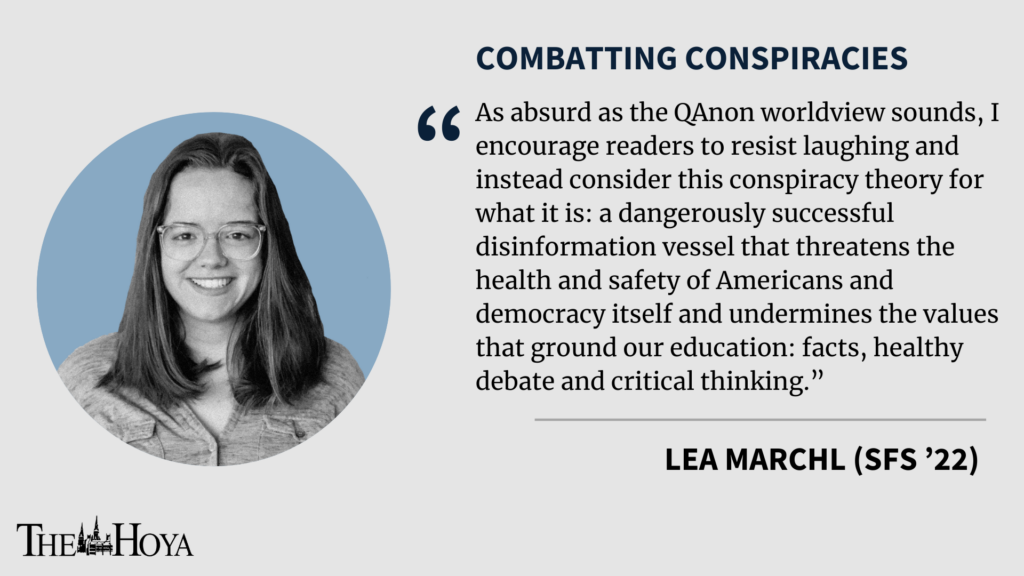At Georgetown University, an institution dedicated to the pursuit of truth, it can be easy to dismiss the disinformation and conspiratorial thinking that has taken over much of the United States. However, we, as students, have a responsibility to understand the nature of this dangerous, anti-democratic trend in order to better address it.
On Jan. 6, the far-right’s terrorist attack in the interest of subverting democracy at the Capitol confirmed what the FBI warned of in 2019: conspiracy theory cults, such as QAnon, are potential terror threats. According to the Network Contagion Research Institute, QAnon is a big tent conspiracy theory, meaning it has absorbed and perpetuated many other conspiracies and combined them with its own central claim: the world is directed by a Satanic cabal of pedophile elites that practice child sacrifice. QAnon originated on 4chan, an anonymous online image-based forum, when a user self-dubbed “Q” claimed to have inside knowledge about President Donald Trump’s plans to arrest prominent members of the Democratic party. As more adherents joined, the narrative emerged that President Trump was ordained by God to fight the “deep state,” a notion based on antisemitic tropes, and was going to save children who had fallen victim to the cabal.
As absurd as the QAnon worldview sounds, I encourage readers to resist laughing and instead consider this conspiracy theory for what it is: a dangerously successful disinformation vessel that threatens the health and safety of Americans and democracy itself and undermines the values that ground our education: facts, healthy debate and critical thinking.
2020 was a prolific year for QAnon. Limited social interactions as a result of the COVID-19 pandemic, paired with YouTube and Facebook’s algorithms known for creating echo chambers, brought millions down the rabbit hole of QAnon. As their ranks grew, QAnon became adept at employing the same tactic Russian troll farms introduced to U.S. media spheres: coordinated inauthentic behavior, defined as “when groups of pages or people work together to mislead others about who they are and what they are doing,” according to Nathaniel Gleicher, head of cybersecurity policy at Facebook. It is hard to overemphasize the harmful effect this has had on public discourse.
A prominent example is #subpoenaObama. Research from the Network Contagion Research Institute shows that the online trend — which influenced President Trump’s attempts to investigate his predecessor — originated from QAnon. On May 13, 2020, a QAnon Twitter account first posted the hashtag #subpoeonaObama and asked its followers to get it trending. Within a minute, the tag was tweeted approximately 40 times, suggesting inorganic growth. The hashtag was based on the unfounded notion that President Obama had spied on President Trump’s 2016 campaign. The next day, the hashtag started trending, at times being retweeted more than 4,000 times an hour. Less than 24 hours after the hashtag’s inception, Trump tweeted at Sen. Lindsey Graham (R-S.C.), the head of the Senate Judiciary Committee, asking him to force Obama to testify. With incredible speed, QAnon managed to push its baseless theories to the forefront of discourse, shoving past more pressing topics such as COVID-19.
Since then, QAnon has time and again taken over conversations and infused them with dangerous falsehoods. In summer 2020, the cult hijacked #savethechildren, a charity fundraising campaign to end childhood poverty and transformed it into a vessel for disinformation. All of a sudden, unsuspecting audiences on Instagram and Facebook were exposed to claims of cabals and endemic pedophilia. What’s more, a number of wellness influencers and mommy bloggers noticed these posts were gaining far more engagement than their regular images. Since then, many accounts have made QAnon more digestible and mainstream by sharing its claims in pastel, aesthetically pleasing infographics.
QAnon ended the year strong by originating the falsehood that Dominion Voting Systems flipped votes for Trump to Biden on Nov. 6 on 8kun, a platform similar to 4chan. The theory quickly made its way to Twitter, and by the next day, prominent and verified conservative activists amplified these claims. After One America News Network picked it up, it took only another three days for President Trump to discuss it on his Twitter feed, exposing tens of millions of Americans to an utter fiction disguised as truth. The Dominion theory became central to President Trump’s claim that the election was stolen and ultimately inspired thousands to breach the Capitol.
As Georgetown students, we spend our days pursuing and establishing knowledge, an endeavor that can seem pointless as an ever-increasing number of Americans reject established truth. A Dec. 30 poll conducted by NPR showed that an incredible 54% of Americans stated that the proposition “a group of Satan-worshipping elites who run a child sex ring are trying to control our politics and media” was either true or they were not sure. Conspiracy theories such as QAnon openly reject the work accomplished in universities such as ours because it contradicts the parallel reality full of disinformation they have constructed for themselves. As future leaders, however, we must reject QAnon’s attempts to steer public discourse into a spiral of violent disinformation and instead work together to find the ways to empathetically help our fellow citizens back to the democratic norms of conversation and fact-based debate.
Lea Marchl is a junior in the School of Foreign Service. Combatting Conspiracies appears online every other Friday.









